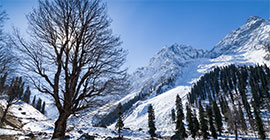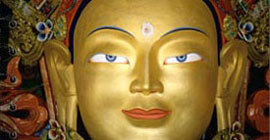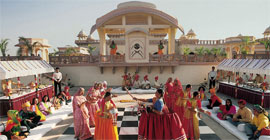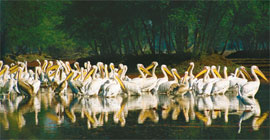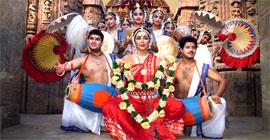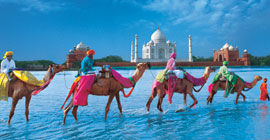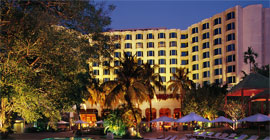jammu
Home | Jammu
Jammu is famous for its landscape, ancient temples, Hindu shrines, castles, gardens and forts. Hindu holy shrines of Amarnath and Vaishno Devi attracts tens of thousands of Hindu devotees every year. Jammu's beautiful natural landscape has made it one of the most famous destinations for adventure tourism in South Asia. Jammu's historic monuments feature a unique blend of Islamic and Hindu architecture styles.
Vaishno Devi shrine
The Vaishno Devi shrine attracts hundreds of thousands of Hindu devotees every year
The town of Katra, which is close to Jammu, is home to the famous Vaishno Devi shrine. Nestling on top of the Trikuta Hills at a height of 1700 m is the sacred cave shrine of Vaishno Devi, the mother goddess. At a distance of 48 km from Jammu, the cave is 30 m long and just 1.5 m high. At the end of the cave are shrines dedicated to the three forms of the mother goddess—Mahakali, Mahalakshmi and Mahasarasvati. Pilgrims start trekking to the cave temple which is 13 km from katra. They enter in small groups through a narrow opening and walk through ice-cold waters to reach the shrines. According to legend, the mother goddess hid in the cave while escaping a demon whom she ultimately killed.
Nandini Wildlife Sanctuary
Areas around Jammu used to be thick forests few years ago teeming with wild life. A wildlife sanctuary, called and best known for wonderful species of pheasants. It is renowned natural habitat for a significant population of pheasants. Among the other avifauna Indian mynah, blue rock pigeon, peafowl, red jungle fowl, chir pheasants, chakor etc.
Spread over an area of 34 km², the sanctuary is rich in fauna and provides refuge to a wide variety of mammals. The main species are leopard, wild boar, rhesus monkey, bharal and grey langur.
Mansar Lake
Situated 62 km from Jammu, Mansar is a beautiful lake fringed by forest-covered hills, over a mile in length by half-a-mile in width. Besides being a popular excursion destination in Jammu, it is also a holy site, sharing the legend and sanctity of Lake Mansarovar. 34°14'54.35N 74°40'3.43E On the Eastern Bank of the Lake there is a shrine of Sheshnag, a mythological snake with six heads. The shrine comprises a big boulder on which are placed a number of iron chains perhaps representing the small serpents waiting on the tutelary deity of the Sheshnag. Two ancient temples of Umapati Mahadev & Narsimha as also a temple of Durga are situated in the vicinity of the Mansar lake. People take a holy dip in the water of the lake on festive occasions.
Newly weds consider it auspicious to perform three circumambulations (‘Parikarma’) around the lake to seek the blessings of Sheshnag, the lord of serpents, whose shrine is located on its eastern bank.
Certain communities of Hindus perform Mundan ceremony (First hair cut) of their male children here.
There are also some ancient temples on the lake’s shores, which are visited by devotees in large numbers. Mansar is also ideal for boating for which the Tourism Department provides adequate facilities.
With all religions belief and heritage behind the Mansar Lake is also picking up its fame among the tourists with all its flora & fauna. The lake has cemented path all around with required illumination, with projected view decks to enjoy flickering of seasonal birds, tortoise and fishes of different species. There is a wild life Sanctuary housing jungle life like Spotted Deer, Neelgai etc. besides other water birds such as Cranes, Ducks etc. One can also witness the traditional and typical distinct life style of Gujjar & Backarwals wearing ethnic costumes, living in open Kullhas around on the hills of Mansar Lake. This Mansar lake road joins to another important road that directly links Pathankot (Punjab) to Udhampur (Jammu & Kashmir, Jammu Province. Udhampur is a Town of strategic importance, again on National Highway No. 1A. The shortcut road from Mansar or Samba to Udhampur by-pass the Jammu town. Surinsar Lake, a smaller lake that is linked to Mansar, is 24 km from Jammu. (via bye-pass road)
Bahu Fort
The Bahu fort, which also serves as a religious temple is situated about 5 km from Jammu city on a rock face on the left bank of the river Tawi. This is perhaps the oldest fort and edifice in the city. Constructed originally by Raja Bahulochan over 3,000 years ago, the existing Fort was more recently improved and rebuilt by Dogra rulers. There is a temple dedicated to the Goddess Kali inside the fort popularly known as Bave wali Mata. The fort overlooks the river running through Jammu city. Every Tuesday and Sunday pilgrims throng this temple and partake in "Tawi flowing worship". Bave Wali Mata is the presiding deity of Jammu. Today the fort is surrounded with a beautiful terraced garden which is a favourite picnic spot of the city folk.
Bagh-E-Bahu located on the banks of Tawi river, is a famous Mughal-age garden. It gives nice view of the old city and Tawi river. Bagh itself is very beautiful. There is a small cafeteria on one side of the garden.
On the by-pass road behind Bahu Fort, the city forest surrounds the ancient Maha Maya Temple overlooking the river Tawi. A small garden surrounded by acres of woods provides a commanding view of the city.
The famous temple of Bawey Wali Mata inside the Bahu Fort attracts pilgrims every Tuesday and Sunday who come here to worship the presiding deity of Jammu while opposite the Bahu Fort, overlooking the River Tawi is a temple dedicated to Mahamaya, a local heroine of Dogras, who lost her life fourteen centuries ago fighting foreign invaders. The present temple of Bawey Wali Mata was built shortly after the coronation of Maharaja Gulab Singh, in 1822. It is also known as the temple of Mahakali and the goddess is considered second only to Mata Vaishno Devi in terms of mystical power.
Raghunath Temple
Amongst the temples in Jammu, the Raghunath Mandir takes pride of place being situated right in the heart of the city. This temple is situated at the city center and was built in 1857. Work on the temple was started by Maharaja Gulab Singh, founder of the Kingdom of Jammu and Kashmir in 1835 AD and was completed by his son Maharaja Ranbir Singh in 1860 AD. The inner walls of the main temple are covered with gold sheet on three sides. There are many galleries with lakhs of saligrams. The surrounding Temples are dedicated to various Gods and Goddesses connected with the epic Ramayana. This temple consists of seven shrines, each with a tower of its own. It is the largest temple complex in northern India. Though 130 years old, the complex is remarkable for sacred scriptures, one of the richest collections of ancient texts and manuscripts in its library. Its arches, surface and niches are undoubtedly influenced by Mughal architecture while the interiors of the temple are plated with gold. The main sanctuary is dedicated to Lord Vishnu's eighth incarnation and Dogras' patron deity, the Rama. It also houses a Sanskrit Library containing rare Sanskrit manuscripts.
Peer Kho Cave
Alongside the same Tawi river are the Peer Kho Cave temple, the Panchbakhtar temple and the Ranbireshwar temple dedicated to Lord Shiva with their own legends and specific days of worship. Peer Kho cave is located on the bank of river Tawi and it is widely believed that Ramayan character Jamvant (the bear god) mated in this cave. The Ranbireshwar Temple has twelve Shiva lingams of crystal measuring 12" to 18" and galleries with thousands of saligrams fixed on stone slabs. Located on the Shalimar Road near the New Secretariat, and built by Maharaja Ranbir Singh in 1883 AD. It has one central lingam measuring seven and a half feet height (2.3 m) and twelve Shiva lingams of crystal measuring from 15 cm to 38 cm and galleries with thousands of Shiva lingams fixed on stone slabs.
Dargah of Ali Shah
The Dargah (shrine) of Peer Budhan Ali Shah or Peer Baba is said to protect the people of this city from mishaps and evil spirits. A friend of Guru Gobind Singh, it is said that Peer Baba lived his entire life on milk alone and lived to the age of five hundred and still people from all faiths and religions venerate him in equal respect. Peer Mitha was a saint who has a shrine of his own and was a contemporary of Ajaib Dev and Ghareeb Nath, who were famous for their prophecies and miracles. "Mitha" means "the sweet one" and the saint was so-called, as the Peer would accept nothing more than a pinch of sugar in offering from his devotees.
City Centers And Attractions
One of the major attractions of Jammu, it is a revolving restaurant named Falak located on the top of the hotel KC Residency. Ragunath Bazar is the main tourist and shopping center of the city. The locality of Gandhi Nagar, hosts the market areas of Gole Market, Apsara Road and Bahu Plaza. On any pleasant evening you can take a stroll in Green Belt Park alongside the magnificent bungalows that adorn Green Belt Road. Rajinder Park, which is located on Canal Road, is a new development. This park is situated between two canals and features a large fountain which is lit up at night. A Children's Area is located next to the park.
Besides this Jammu is famous for its exotic local food and Rajma (with rice) is one of the specialty dishes of Jammu.







